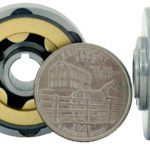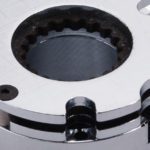Mach III, Kentucky-based designer and manufacturer of custom and standard brakes, clutches, and torque limiters (to connect and disconnect, stop, hold, tension, and protect machines and operators) now has a new website at machiii.com. Better features. Better options. Better hurry and check it out … The new Mach III website includes reorganized content, streamlined navigation, […]
machIII
Trends: Brakes and clutches take miniaturization to new extremes
Clutches and brakes as well as torque limiters continue to evolve as the requirements for new applications for holding, stopping, and indexing continue to multiply. The ongoing trend for these technologies towards application-specific variations continues unabated — especially as several industries have exceeded capabilities of legacy stock parts. “Mach III has experienced a strong increase […]
Video: What is a torque limiter?
Torque limiters are mechanical and electromechanical power-transmission devices that protect machine sections (or workpieces they’re servicing) from overloads, crashes, and damage from jams. Torque limiters work either by slipping or completely disconnecting the drive from the driven load. Some torque limiters of the former type (especially those employing friction plates) are also called slip clutches. […]
Mach III Clutch Inc. supplies mechanical friction torque limiter for fish-barrier hoist
Reclamation District 108 is a 150-year-old water district located in the Sacramento Valley that provides irrigation, drainage, and flood protection to farms and rural communities in the area. But drainage and flood-control canals in this region pose a risk to adult salmon who return from the sea through the San Francisco Bay to make their […]
Video on torque limiters: Examples of how to customize for industrial applications
In a recent video with Lee Teschler, we go over three torque limiters from Mach III — a Kentucky-based manufacturer of stock and custom brakes, clutches, and torque limiters. The manufacturer can usually deliver custom designs within two days of obtaining application requirements. Mach III also meets or beats purchase-order ship dates 98% of the time. […]
Video: Spring or air-engaged friction brakes from Mach III (a Design World overview)
In a recent video with Lee Teschler, we got the chance to handle two brakes from Mach III. Watch the video: Our first sample — a D2F3R-STH spring-engaged brake — is one of more than a dozen standard variations … with many more customizable options. This modular brake design has subcomponents grouped into kits — […]
Video: Five air-engaged clutches from Mach III (a Design World overview)
In a recent video with Lee Teschler, we investigated five air-engaged clutches from Mach III. The company designs and manufactures an array of air and spring-applied friction brakes and clutches — as well as mechanical torque limiters and combination clutch-brakes for industrial applications to 5,000 ft-lb. Watch the video: First we detail a C2H2R-STH […]
Miniature brakes, clutches, and torque limiters from Mach III for shaft sizes to a half-inch
Brakes, clutches and torque limiters are now available from Mach III for shaft sizes of half-inch and smaller. The ten new products include: • A spring-engaged brake for power off applications • An air-engaged brake for stopping and holding applications • Five air-engaged clutch configurations for connect and disconnect applications • Three mechanical torque limiters […]
Brakes and clutches: Top trends in IoT — and uses on ac-motor conveyors and servodesigns
Clutches and brakes work in motion systems to stop or hold or index axes — but must do so to application specifications. No wonder then that the trend in this technology is away strictly stock parts. According to Lesli Riehemann, president at Mach III Clutch Inc., customized brakes and clutches are now 75 to 80% […]
Example of tight torque-limiter integration for overload protection
Ideally engineers would anticipate the need for overload protection in a drivetrain and include it in the original design. But overload problems often only appear after equipment is in use. Such designs require torque-limiter retrofits, even if existing assembly geometry is tight. Making the issue more challenging is that end users often want a solution […]











